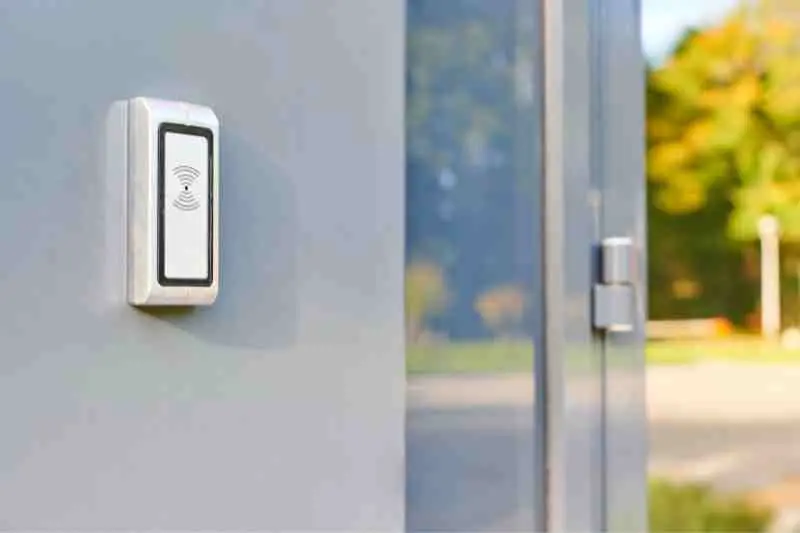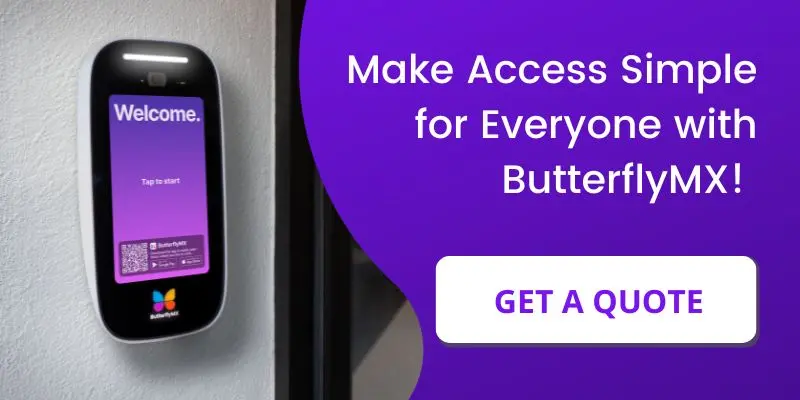Key takeaways
- The best contactless RFID card reader is ButterflyMX.
- RFID readers work by wirelessly communicating with RFID-enabled cards or tags.
- Using an RFID card and reader empowers quick and contactless access for authorized users.
- Consult the specific installation manual provided by your RFID card reader manufacturer to properly install the reader.
- Choose the best RFID reader for your property by evaluating your building’s specific needs for tailored and customized access control.

As a property manager or owner, staying ahead of the curve is crucial for ensuring the security and overall efficiency of your properties. As such, access control readers, like RFID card readers, are an integral component of managing access to and throughout your properties.
In this guide, we’ll explore the five best RFID card readers on the market. Next, learn what an RFID card reader does and how it works. Finally, discover how to install and choose the best RFID card reader for your property.
This post covers:
- 5 best RFID card readers
- How do RFID card readers work?
- How to install RFID card readers
- How do I choose an RFID reader?
5 best RFID card readers
Looking to unlock the gateway to seamless security and access control? In the section below, we break down the top five readers and what you can expect from them.
Here are the five best RFID card readers on the market:
1. ButterflyMX
ButterflyMX isn’t your average mobile RFID card reader. In fact, ButterflyMX’s robust access control system offers in-hardware RFID and WiFi connectivity, empowering you to unlock your door or gate in multiple ways.
Here’s why ButterflyMX is the best solution for managing access to your property:
- State-of-the-art video intercom. The ButterflyMX video intercom offers convenient and contactless property access.
- 156-degree wide-angle camera. View visitors without blindspots for enhanced security and transparency of all entry events.
- Five-star mobile app. Open any access point with just a swipe of a smartphone with the top-rated ButterflyMX mobile app.
- Elevator controls. Manage access to certain floors with your key-fobbed elevator so only authorized individuals can access secured areas.
- Smart locks. Go keyless using smart lock integrations with 80+ trusted brands and models.
- Temporary digital keys. Offer secure yet convenient access by sending temporary virtual keys to visitors and service providers.
- Delivery passes. Enable seamless deliveries for couriers and eliminate package theft with delivery passes.
2. Doorking
Offering long range RFID card readers, Doorking provides a variety of solutions for properties of all types.
What to expect from Doorking:
- Versatile mounting styles.
- Long-distance RFID card readers up to 25 feet.
- Suitable for indoor and outdoor use.
- Durable and vandal-resistant.
3. HID Global
HID Global offers a variety of HID RFID card readers for industries that need heightened security, like healthcare, pharmaceutical, enterprise, government, and financial services.
Features you find with HID Global include:
- Offers a mini-mullion contactless reader that’s perfect for securing doors.
- Provides stationary readers and antennas for retail, parking, and industrial facilities.
- Choose between handheld or mounted readers.
- Supports 125 kHz RFID frequencies.
4. Verkada
Offering contactless RFID card readers, Verkada offers elevated security for doors and entrances.
More features include:
- Low and high-frequency card compatibility.
- Sleek design.
- Green or red LED feedback lights indicate granted or denied access.
- IP65-rating.
5. 2N Access Unit 2.0
2N provides a Bluetooth RFID card reader that’s flexible and versatile for your convenience.
Further features of 2N include:
- Wireless RFID card reader supports 125 kHz and 13.56 MHz frequencies.
- Sleek and stylish design.
- Comes in several design finishes.
- Mobile phone compatibility.
How do RFID card readers work?
An RFID (radio-frequency identification) card reader works by wirelessly communicating with RFID-enabled cards or tags. To do this, an RFID card reader processes and captures the data stored on these cards or tags using radio frequency signals.
Learn how ButterflyMX works:
What does an RFID card reader do?
RFID card readers empower authorized individuals to access properties or secured areas by presenting their RFID cards to the reader.
Beyond access control, RFID proximity card readers are often used in asset tracking, inventory management, and contactless payment systems.
What is the difference between an RFID tag and an RFID reader?
The main difference between an RFID tag and an RFID reader lies in their function. To explain, an RFID tag carries the data that is embedded in a card or key fob.
In contrast, an RFID reader is the device that reads the tag’s data and communicates between the tag and a larger access control system or database.
What is the difference between NFC and RFID?
The main difference between NFC and RFID is that NFC (near-field communication) has a shorter range and higher frequencies. So, NFC is mainly used in close-range interactions between devices. As a result, NFC devices are ideal for door access control, mobile ticketing, and contactless payment systems.
In contrast, RFID has a broader range of applications and wider operating distances. So, they’re better suited for gate and vehicle access control.
Can I use my iPhone as an RFID card?
Yes. If you have a smart RFID reader, like a video intercom, you can use your smartphone as a key fob to open doors, gates, and other entry points.

How to install RFID card readers
To properly install an RFID access card reader, it’s crucial to hire a certified installer and consult the specific installation manual provided by your RFID card reader manufacturer.
Moreover, installation steps may vary based on the model and type of reader you’re working with.
However, here are some general tips on installing an RFID system:
- Select the right RFID reader. Choose an RFID badge reader that suits your property’s specific requirements. So, consider factors like communication range, frequency, and compatibility with your existing access control system.
- Determine the best reader placement. Identify strategic locations for installing RFID card readers like entry points, turnstiles, gates, doors, and other access control points.
- Prepare the mounting surface. Ensure that the mounting surface is clean, flat, and stable.
- Set up power supply and connectivity. Many RFID ID card readers are powered through ethernet or a separate power supply. What’s more, readers require network connectivity to work properly.
- Configure the RFID Card Reader. Set up parameters like communication protocols and security settings.
- Integrate the reader with your access control system. Connect the reader with your access control system’s central controller and RFID card reader software.
How do I choose an RFID reader?
To choose the best RFID reader for your property, evaluate your building’s needs for security, convenience, and ease of use.
Here are some more key considerations to guide you in selecting the right RFID reader for your property:
- Frequency and range. Choose a frequency that aligns with your property’s needs. For instance, different RFID readers have varying ranges and distances — such as gate readers or door readers. Therefore, you need to ensure that the reader’s range suits the distance that you need to read RFID cards or tags.
- Read speed. A reader with a fast read speed is essential for high-traffic properties with a lot of frequent visitors. With a rapid reader, you can help prevent pile-ups at your door or gate.
- Card compatibility. Check the compatibility of the RFID reader with the types of RFID tags or cards you plan to use. With this in mind, this guarantees that the reader supports the frequency of your RFID cards.
- Consider your environment. If your reader will be exposed to harsh weather or extreme temperatures, choose a reader with the appropriate level of durability and a high IP rating.
- Security. Look for features like encryption, authentication, and vandal resistance to enhance the overall security of your access control system.
- Scalability. Choose a solution that can easily scale to accommodate additional users, doors, or access points as your property grows.

